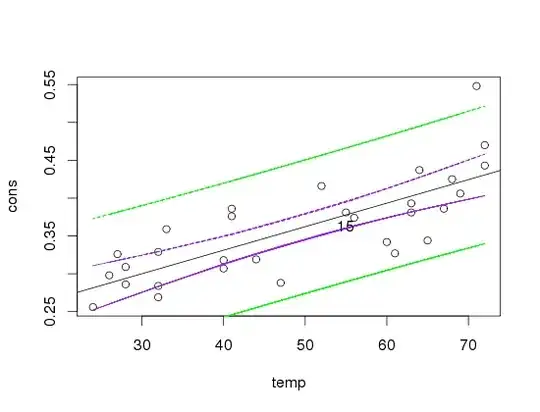Okay, so I am trying to understand linear regression. I've got a data set and it looks all quite alright, but I am confused. This is my linear model-summary:
Coefficients:
Estimate Std. Error t value Pr(>|t|)
(Intercept) 0.2068621 0.0247002 8.375 4.13e-09 ***
temp 0.0031074 0.0004779 6.502 4.79e-07 ***
---
Signif. codes: 0 ‘***’ 0.001 ‘**’ 0.01 ‘*’ 0.05 ‘.’ 0.1 ‘ ’ 1
Residual standard error: 0.04226 on 28 degrees of freedom
Multiple R-squared: 0.6016, Adjusted R-squared: 0.5874
F-statistic: 42.28 on 1 and 28 DF, p-value: 4.789e-07
so, the p-value is really low, which means it is very unlikely to get the correlation between x,y just by chance. If I plot it and then draw the regression line it looks like this:

Blue lines = confidence interval
Green lines = prediction interval
Now, a lot of the points do not fall into the confidence interval, why would that happen? I think none of the datapoints falls on the regression line b/c they are just quite far away from each other, but what I am not sure of: Is this a real problem? They still are around the regression line and you can totally see a pattern. But is that enough? I'm trying to figure it out, but I just keep asking myself the same questions over and over again.
What I thought of so far: The confidence interval says that if you calculate CI's over and over again, in 95% of the times the true mean falls into the CI. So: It it is not a problem that the dp do not fall into it, as these are not the means really. The prediction interval on the other hand says, that if you calculate PI's over and over again, in 95% of the times the true VALUE falls into the interval. So, it is quite important to have the points in it (which I do have). Then I've read the PI always has to have a wider range than the CI. Why is that? This is what I have done:
conf<-predict(fm, interval=c("confidence"))
prd<-predict(fm, interval=c("prediction"))
and then I plotted it by:
matlines(temp,conf[,c("lwr","upr")], col="red")
matlines(temp,prd[,c("lwr","upr")], col="red")
Now, if I calculate CI and PI for additional data, it does not matter how wide I choose the range, I get the exact same lines as above. I cannot understand. What does that mean? This would then be:
conf<-predict(fm,newdata=data.frame(x=newx), interval=c("confidence"))
prd<-predict(fm,newdata=data.frame(x=newx), interval=c("prediction"))
for new x I chose different sequences. If the sequence has a different # of observations than the variables in my regression, I am getting a warning. Why would that be?